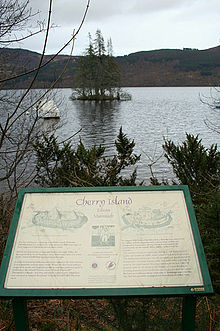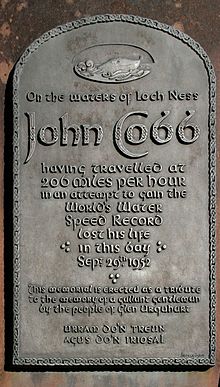Loch Ness
| Loch Ness | ||
|---|---|---|

|
||
| Loch Ness as seen from the east end | ||
| Geographical location | Great Glen, Highland, Scotland | |
| Tributaries | River Oich , Foyers , Moriston, Enrick, River Farigaig | |
| Drain | River Ness → Moray Firth → North Sea | |
| Places on the shore | Fort Augustus , Drumnadrochit | |
| Location close to the shore | Inverness | |
| Data | ||
| Coordinates | 57 ° 19 ′ N , 4 ° 26 ′ W | |
|
|
||
| Altitude above sea level | 16 m | |
| surface | 56.4 km² | |
| length | 37 km | |
| width | 1.5 km | |
| volume | 7.4 km³ | |
| Maximum depth | 230 m | |
| Middle deep | 132 m | |
|
particularities |
- Lake with the richest water in the British Isles |
|
Loch Ness [ ˌlɒx ˈnɛs ] ( Scottish Gaelic : Loch Nis [ ˈlɔx ˈnɪʃ ]) is a freshwater lake in the Scottish highlands. It is located in the Highland Council Area about ten kilometers southwest of Inverness in the Great Glen . Measured on the water surface of 56.4 km² Loch Ness is the second largest lake in Scotland after Loch Lomond . However, due to its depth, it has by far the largest volume of water of all Scottish lakes.
description

Loch Ness has the typical elongated shape of a lake formed by glaciers in the Ice Age . It is about 37 km long, but on average only 1.5 km wide. Towards the end of the Ice Age about 12,000 years ago, Loch Ness was probably still a bay. When the land near Inverness, freed from glacial ice, rose, access to the sea was cut off.
The greatest depth of the lake is 230 m. Measurements that showed a depth of 247 m or 325 m are attributed to faults in the sonar measuring devices, are considered unreliable and could not be confirmed even with new measurements. After Loch Morar (310 m), Loch Ness is the second deepest lake in the British Isles, but has the greatest mean depth at 132 m. In contrast to other Scottish lochs, most of the lake is very deep. In fact, almost half (47.7%) of the lake area has a water depth of more than 152 m. Only under 13.6% of the lake area is the water shallower than 30 m, while these relatively shallow areas make up 68% of the water surface at Loch Lomond and 42% at Loch Morar.
Deposits from the River Foyer divide Loch Ness into two deep basins roughly in the middle. Every year the deposits on the ground increase by an average of about one millimeter. The steeply sloping walls of the lake are also significant bathymetrically. In some sections, the lake reaches a depth of 53 m less than 15 m from the shore, which corresponds to a slope falling at an angle of 75 °.
Loch Ness has been integrated into the Caledonian Canal since 1822 . This was built as a connection between the Atlantic coast and the North Sea coast in order to achieve shorter transport times for industrial goods and to avoid the storms on the sea in the north of Scotland. For the construction of the canal, the water level in the lake was artificially raised by about three meters, which also increased the length and width of the lake.
Apart from a small island in the delta of the River Foyers, there are no other natural islands in Loch Ness. In the southwest of the lake is Cherry Island , an approximately 4000 year old artificial island (a so-called Crannóg ) from the Bronze Age. Due to the artificially increased water level, only a fraction of its original size is visible today from Cherry Island. Another former Crannóg - Dog Island - was completely flooded when the water level rose.
Loch Ness flora and fauna
Loch Ness is one of the UK's richest in fish. Salmon , eels , minnows , trout , pike and sticklebacks live in the lake . Like Loch Oich and Loch Lochy , Loch Ness serves as a spawning ground for Atlantic salmon that have migrated from the sea in autumn. In 1982 three specimens of this species were caught in Loch Ness at a depth of around 220 meters - a record for depth in British freshwater lakes. In 2000 the record catch of a 7.5 kilogram trout was achieved.
Oak , ash , mountain ash , hazelnut and pine grow in the woods around Loch Ness . Most oak trees, however, were felled in the early 19th century for the construction of the Caledonian Canal.
Sporting events
Although Loch Ness is very cold even in the warm season, some swimmers have crossed the lake lengthways (about 37 km). The record holder is David Morgan: he completed the one-way distance in 10 hours and 59 minutes and the double in 23 hours and 50 minutes. On September 29, 1952, John Cobb's attempt to break the world speed record on the water with a motorboat in Loch Ness was fatal . Cobb's Speedboat Crusader took off from the surface of the water at a speed of more than 320 km / h and broke on re-impact.
The Loch Ness Marathon has been held every fall since 2002. It starts at Whitebridge and leads along a narrow road along the southeastern bank. After Dores, the route leaves the lake towards Inverness. The last few kilometers lead along the south-east bank of the Ness, then over a stone bridge in Inverness on the other side back to Bught Park. In 2011 around 2500 active participants took part in this marathon.
The Loch Ness Monster
For centuries there have been reports of sightings of a sea monster called Nessie in Loch Ness . Based on these reports, Loch Ness is a popular tourist destination and arguably the most famous of all Scottish lakes. The center of Nessie tourism is the village of Drumnadrochit .
Others
About 1,700 meters northeast of the mouth of the foyer in Loch Ness is the property Boleskine House above the lake . The building was inhabited from 1899 to 1913 by the occultist Aleister Crowley . From the early 1970s to 1991, it belonged to rock musician Jimmy Page of the Led Zeppelin band and was also used for some scenes in the musical film The Song Remains the Same .
On December 31, 1940 crashed a twin-engine bomber of the Royal Air Force of type Vickers Wellington into the lake, where a crew member was killed. The wreck of the machine was salvaged from the lake in 1985, then restored and is now on display in the Brooklands Museum in Brooklands in the south of England .
The company Kongsberg Maritime has been surveying the lake bed with sonar since April 2016 and found the suspected Nessie dummy from the shooting of the film The Private Life of Sherlock Holmes from 1969 on the bottom .
Web links
- Description of the lake ( English )
- www.lochness.com ( English )
- The Origin of the Earth: Loch Ness. ZDF Mediathek; to geology
Individual evidence
- ^ J. Murray, L. Pullar: Bathymetrical survey of the fresh-water lochs of Scotland. Part XIII - Lochs of the Ness Basin (PDF; 954 kB), Geographical Journal, 30 (1907), pp. 62-71.
- ↑ lochnessinvestigation.com: FAQ: Have you ever investigated the depression known as “Edward's Deep”? Retrieved May 27, 2010.
- ^ Ove Ronne Haraldsen: Reveals The Secret Of The Deep. In: K-Magazine. October 26, 2016. Retrieved August 18, 2017 .
- ↑ http://orf.at/#/stories/2334817/ Lost monster dummy discovered in Loch Ness, orf.at, April 15, 2016, accessed April 15, 2016


